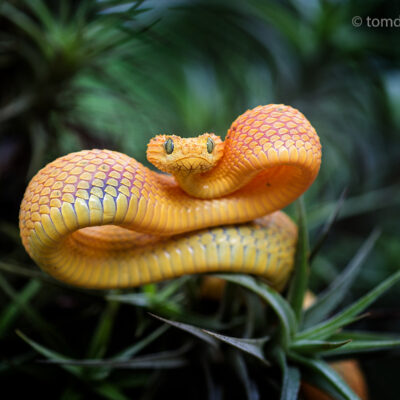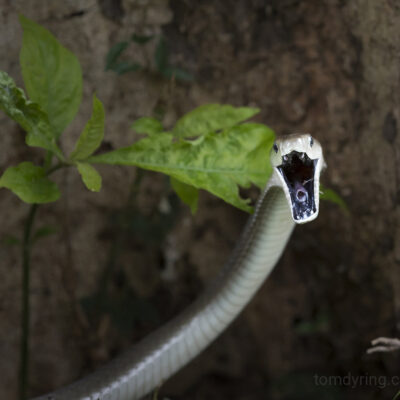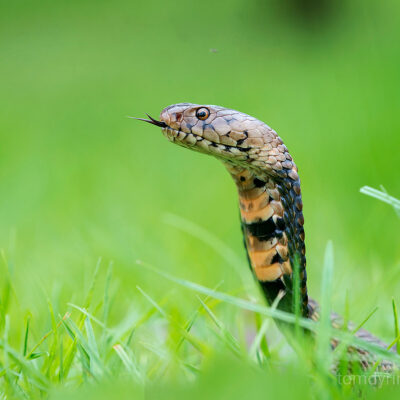Norwegian photographer Tom Dyring is passionate about wildlife and fascinated by snakes. His work is fuelled by a deep respect for nature and the individual ‘posing’ in front of his camera. The snakes in his pictures look elegant and enigmatic, demonstrating a distinct personality. We asked him about the work behind the scenes and if the snakes live up to their dangerous reputation.
Fascinating creatures
“All creatures, big and small, have always interested me, but snakes draw extra attention,” Tom says when asked about his love for snakes. “Even as a kid, I caught them in my neighbourhood and kept them in my room to study them. I’m sorry now that I realise how they must have suffered … Today, at 75, I still feel the same fascination.
First of all, snakes have an extremely interesting biology. They’ve been around for 120 million years, and through time and evolution, they have created unique biological systems, especially for creating venom. The more I study this, the more amazed I am.
Then there is the cultural side. Snakes have always triggered man’s imagination. People have attributed supernatural powers to snakes for hundreds of years. Christians put the snake in Paradise; in Africa, snakes are believed to be ancestors who have returned to Earth to take people to the other side. In other parts of the world, snakes represent fertility.
I’m also amazed by the irrational fear of snakes, ophidiophobia. So many people have this, while they have often never seen a snake and probably never will.
Finally, I admit that the fact that some species are extremely dangerous turns me on. The danger they represent elicits my respect. I don’t have a death wish, but we can learn so much from them. You just have to know what triggers them.
Once there was a snake …
With my photography, I want to tell a story. Just something about the species, situation, or animal you see. This will help you be in the moment of the pictures, and give you more respect for the snakes. So, let me tell you the story behind some images. That way, you will remember them well.
In search of the black mamba
A few years back, I wanted to document the black mamba. So, I contacted Mike Perry, the godfather of herpetology in South Africa, and convinced him to travel with me for two weeks to look for snakes.
One evening, we were sitting outside our shack when he suddenly got up, walked to a barrel, kicked it over … and out came a 3,5 m black mamba! Then he looked at me with his big eyes, and I will never forget how he said: “Just catch it, Tom!”
I froze. I couldn’t move! I was quite terrified. Also, I had promised my wife never to do something stupid, and this seemed to fit the description. But he said: “Tom, it’s getting away, catch it!” And I had worked so hard to convince him to cooperate with me … I just knew that if I didn’t act, he would send me back on the next flight to Norway. So, I ran after that mamba with a steel hook until, after a while, it got slower and was getting tired. So I pulled it back, grabbed the tail, put the hook over the neck, and there it was: I was holding the black mamba! I brought it back to Mike, put it in the barrel, and off we went. We shot some excellent pictures when we set the snake free.
The black mamba is an open landscape species; you won’t find them in the forest. Apart from a couple of snakes in Australia, it’s one of the most dangerous species on the planet. It’s not necessarily aggressive but very nervous and unpredictable, and the bite is 100% lethal. Nobody survives it if you don’t get the antivenom within 1 or 2 hours. That’s why I exceptionally carried the antivenom with me on this trip.
The sidewinder doesn’t sleep at night
Sidewinders are remarkable creatures. They are night active in the Arizona desert. During the day, it’s too hot, so they creep into holes for protection and come back up at night. While they are venomous, they are shy and nocturnal, so they don’t bite humans often. They feed on rodents and lizards mostly.
I found this one in the middle of the night and stayed with it until dawn to get the perfect light. I shot this image when the first light peeked over the low horizon.
You know, snakes have the reputation of being extremely dangerous, but it really depends on the species. Some snakes are just relaxed and do very little. When I visited the Asian jungles during the early monsoon, I saw a pit viper that stayed on the same branch for weeks, waiting for preys to come. Six weeks later, it was still sitting on the same branch!”
Nine lives
So, how dangerous has snake photography been for Tom over the years? “All in all, I would say I’ve only experienced 1,5 dangerous situations”, he says after some thought.
“The half dangerous one was with the Mozambique spitting cobra. It can spray venom accurately within about 3 meters and will aim for your face. If the venom gets in your eyes, you can go blind — an experience that comes with a massive load of pain.
When I was shooting this one from up close, it sprayed me in the face! I was, luckily, wearing glasses, but I could feel drops of the venom on my lips. Now, snake venom is built up from proteins that can quickly be taken down by enzymes, which are in our spit. That’s why snakes can eat their own envenomated prey. I did not have any wounds in my mouth, so I decided to be one of the only people in the world to taste snake venom. So, I licked my lips and tasted it. It was like a highly bitter pill. But I knew what I was doing, so no harm was done.
When did it get really unsafe? Contrary to what you might think, it was not the shot with the black mamba but with a western diamondback rattlesnake in Arizona. This is one of the biggest rattlesnakes in the world; it can grow up to 2 meters long and weigh 7 kg. And it has the reputation of being grumpy (smiles). This is great for photography, because they will choose confrontation instead of escape, so they will come toward you and lift their head, which is precisely the shot you want.
I was thrilled we found this big one, but it was so angry! It was coming after me in the grass; I had to take my distance while my friend drew its attention and kept it under control. He had a steel hook in one hand and a snake glove over the other, up to his elbow. No snake can bite through that. When the snake finally posed precisely how I wanted it to, granting me the perfect picture while I was lying on my chest on the ground, it suddenly reached out and bit my friend on the glove. He had to shake it off, and as he did, the snake released its grip and came flying, and it landed in my face! It gripped its body around my head; I could hardly breathe. Right then, I thought: this is the end. There will be no hospital that can save me. And I did the only thing you can do: I remained completely still.
I have no clue how long we were lying there like that, but a miracle ensued: after a long time, I could feel the snake moving, loosening its grip and sliding over my face and body, along my leg, into the grass … and it disappeared. I decided then and there that I must have 9 lives. And I don’t think I’ve used them all, so I have a couple left to make more exciting pictures!
Tom is one of Mr Jan Gear’s ambassadors. He met Jan at a photo festival in Norway, after which they became friends and traveled, floating their hides in Latvia, Iceland, and Lithuania. “I always use the Boris backpack; it’s just the right size for maximum hand luggage on airplanes and highly durable. The square corners enable me to put in more stuff. I also have the Ronconi box in my regular suitcase, and use the rain covers on my big lenses. They protect my lenses against dust, rain, snow, humidity … Whatever the weather, they never come off.”
All images © Tom Dyring: www.tomdyring.com and www.facebook.com/tomdyring














